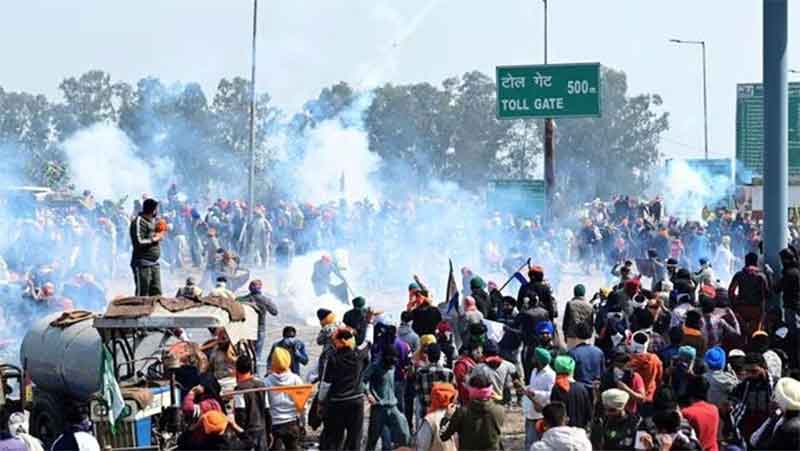
When people from different parts of country, representing the same economic class, decide to protest against the central government, what does this really indicate? Yes, this clearly refers to farmers having apparently decided to protest again as they did for 13 months till December 2021 against certain policies of the government. The earlier protest ceased following several claims made by the government. However, “failure” of the claims’ implementation has led the farmers take to streets again. With parliamentary elections round the corner and as reports indicate that farmers are well prepared to camp for several months, where does this place the central leaders? From one angle, if the government had paid serious as well as genuine attention to grievances of farmers, they may not have been compelled to protest again. From another angle, something seems amiss in certain speculations being voiced regarding it being impossible for the government to yield to farmers’ demand for Minimum Support Price (MSP) and other issues, as desired by the latter. If this view is for a moment accepted as genuine, should the government’s reaction be marked by using tear-gas against protesting farmers and prevent them from entering Delhi?
What is wrong with a march by any number and/or section of the population if it is peaceful and does not spell major disturbance for other citizens? If religious and political marches can be permitted, why should one voicing economic grievances be restricted? Farmers constitute more than 60% of country’s population for whom agriculture is main source of income, which contributes to around 25% of national income. Economically and socially, it seems strange that attempts are being made to silence their political voice and not allowing farmers entry into the capital city. As mentioned earlier, this is not the first time that farmers have voiced their demands. If probably some genuine attempt had been made to pay greater attention to the same, the situation may not reached this stage of crisis. The government’s reported stand is that it cannot afford to yield to farmers’ demand for MSP.
To a degree, with farmers’ march including their tractors, inconvenience caused to others cannot be totally ignored. Nevertheless, this does not justify the use of teargas and other steps causing physical injury to protesting farmers. Think of it from another angle. Rather than take steps at least symbolizing government’s efforts to genuinely consider their demands, this amounts to brushing them aside forcibly as if they have no significance for the government and the country. In addition, this also suggests government’s reluctance and perhaps even practically refusal to even consider their demands. Now, politically, particularly when elections are near, display of such attitude on any economic issue towards affected sections hardly signals exercise of wise politicking. The fact that farmers form a major vote-bank cannot be sidelined. Bharatiya Janata Party (BJP) is apparently more confident about its political strength in urban areas than in rural. Having succeeded in 2014 and 2019 parliamentary elections, the BJP is confident about returning to power in 2024 despite their being no major upswing in its rural popularity.
It may be recalled, ahead of Punjab assembly polls in 2022, in its electoral manifesto BJP did make many promises to farmers regarding debt waiver, extension of center’s MSP policies and so on. But BJP did not win elections and as apparent, the central government has failed to satisfy promises earlier laid out before protesting farmers. Empty promises, loud rhetoric and so forth have limited temporal as well as political value. They sound great to those making them but float like empty balloons, bursting like the same, to whom they are addressed. Clearly, they can silence protestors for a while but not for long as is the case of farmers dissatisfied, frustrated and probably also angry at government’s attitude towards them.
Certainly, the government may have a point about not being financially strong enough to yield to all demands of farmers particularly regarding MSP. The government hasn’t used these words but this is definitely suggested by its response, which is paradoxically being strongly reported in certain sections. The government will have to spend Rs 10 lakh crore, which reportedly, is not “feasible” and will require cut in spending on infrastructure, defense and/or increase in taxation. This demand for MSP has also been described as “politically motivated.” From this angle, it isn’t surprising that two rounds of talks between the center and farmer leaders failed to yield any solution. The next round is scheduled for Sunday (February 18). Besides, farmers’ decision to continue their protest has not changed by simply holding of such talks. They are looking forward for effective solutions to their grievances and are not likely to be satisfied by just talks.
Whether the farmers’ demand is “politically motivated” or the approach of power-holders is, as suggested by reports, there is yet another side to farmers’ grievances, which cannot be ignored. What can be said and what should be done about increase in deaths by suicide of those engaged in farming? These include farmers as well as agricultural laborers. Data released by National Crime Records Bureau (NCRB) on December 4, 2023 indicates that 11,290 suicide cases were reported in 2022. In 2021, 10,281 such deaths were reported. In 2022, there was an increase of 3.7% in comparison to 2021, of 5.7% with figures of 2020. These figures have remained high over the past six years with around 30 engaged in agriculture committing suicide daily, that is at least one such death taking place each hour. If farmers’ grievances are not taken serious note of, it also amounts to ignoring more than 50% of country’s population.
Understandably, each and every issue cannot be resolved at one go but at least needed steps beyond rhetoric need to be taken in this direction. Treating their protest as “politically motivated” doesn’t justify rhetoric and/or tacit tactic of not taking positive steps to favor them. Enhancing rural-oriented employment opportunities, facilitating banking services, increasing educational, medical and other basic facilities in villages in addition to improving their roadways may also be considered a part of infrastructural services needed for progress in most rural areas. Nearly 70% of India’s land is rural. In this context, even if 60% of budget, the government has reportedly kept aside for the country’s infrastructure is used to address protesting farmers’ grievances, it is likely to go a long way in resolving at least a great part of problems they seem to be frustrated by. And if rhetoric-filled balloons are floated once again, they will burst again, only angering agitated farmers further. The government may choose to turn a blind eye to them but not all are going to remain oblivious of increase in deaths by suicide of those engaged in farming. At least this should serve as a wake-up call for power-holders!
Nilofar Suhrawardy is a senior journalist and writer with specialization in communication studies and nuclear diplomacy. She has come out with several books. These include:– Modi’s Victory, A Lesson for the Congress…? (2019); Arab Spring, Not Just a Mirage! (2019), Image and Substance, Modi’s First Year in Office (2015) and Ayodhya Without the Communal Stamp, In the Name of Indian Secularism (2006).














































